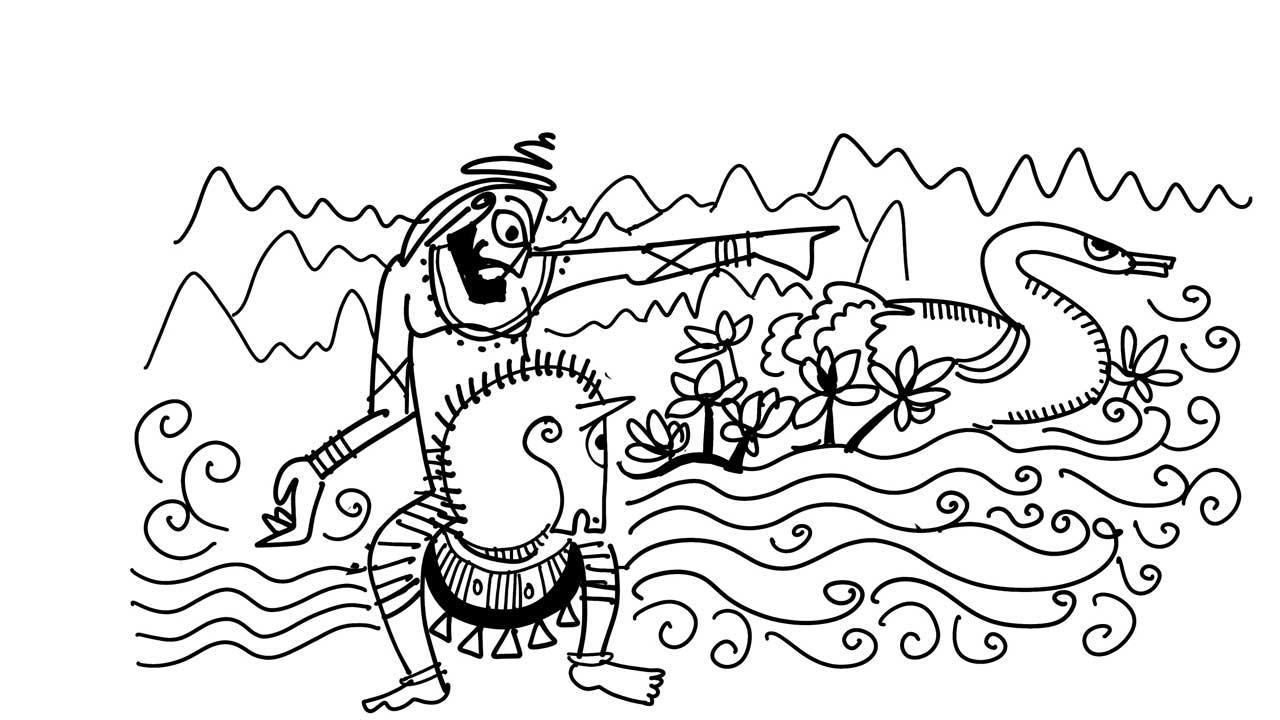There is another Saraswati river that flows through the city of Indore, in Madhya Pradesh.

Illustration/Devdutt Pattanaik
 In Gujarat, there is a river called Saraswati that originates in the Aravalli mountains, and runs for 350 km. In Uttarakhand, there is another Saraswati river that is a tributary of the Alakananda that joins the river near Badrinath. There is another Saraswati river that flows through the city of Indore, in Madhya Pradesh.
In Gujarat, there is a river called Saraswati that originates in the Aravalli mountains, and runs for 350 km. In Uttarakhand, there is another Saraswati river that is a tributary of the Alakananda that joins the river near Badrinath. There is another Saraswati river that flows through the city of Indore, in Madhya Pradesh.
ADVERTISEMENT
Rivers do not give themselves names. People give them names. People identified these rivers as Saraswati, perhaps in memory of the great river that is mentioned in the Rig Veda. In pilgrim lore, this river disappeared at Prayag, where Ganga and Yamuna meet. In caste lore, many Brahmin communities in South and West India believe their ancestors lived on the banks of this river. As per another folk belief, a great drought forced many Brahmins to leave the region watered by the river Saraswati. Those who remained forgot the Vedas in starvation. But a sage called Saraswat ate river fish, survived, and remembered everything.
Avesta texts from Iran speak of a river called Haraxvati, now called Arghandab, a 400 km-long tributary of the Helmand river. In Afghanistan, where Sindhu is pronounced as Hindu, where Sindh becomes Hind, Haraxvati becomes Saraswati. It appearance is very similar to the description of the Saraswati river in Rig Veda (VI.61.2): By means of her gushing and powerful waves, this has crushed the ridge of the mountains, like a man who digs for lotus roots; with praises and prayers, we solicit Sarasvatī for her help, she who slays the foreigners.
Also Read: Losing and gaining the head
Rig Veda was composed over centuries, 3,000 years ago. In later portions of Rig Veda, Saraswati loses its prominence. It is no longer the mother of rivers (Nadiatma). Greater value is placed to the river Sindhu, which we now know as the Indus. We find three references to the Yamuna river and one reference to Ganga. This suggests that the people composing the Rig Veda, known as Arya, were moving eastwards from Afghanistan, through the Indus towards Gangetic plains. This is now corroborated by ancient DNA evidence. This movement began four centuries after Harappan cities collapsed and continued for a few centuries in waves. In the Panchavimsha Brahmana of the Sama Veda, dated to around 800 BCE. Saraswati is described as no longer able to hold up the heavens and consequently have gone underground (Vinashana).
Many Harappan cities have been found along an old river basin parallel to the Indus known as Ghaggar-Hakra River. It once was connected to Sutlej to its west and Yamuna to its east. It now flows into the Thar desert. Many have argued that this was the Vedic Saraswati, and this is where Vedas were actually composed, hence insist on referring to Harappan civilisation as Indus-Saraswati civilisation. This river is currently rain fed and seasonal. If it was a mighty snowfed river, it would have been so over 20,000 years ago, long before farming was invented. Nothing about the current river matches the grand description found in the Rig Veda.
In temples across India, we find images of Ganga and Yamuna seated on dolphins and a turtle on either side of a temple. The third river, Saraswati, who rides a goose, perhaps is the invisible river of knowledge that we can find when we truly look upon the gods and solve the puzzle of their iconography.
The author writes and lectures on the relevance of mythology in modern times. Reach him at devdutt.pattanaik@mid-day.com
 Subscribe today by clicking the link and stay updated with the latest news!" Click here!
Subscribe today by clicking the link and stay updated with the latest news!" Click here!







